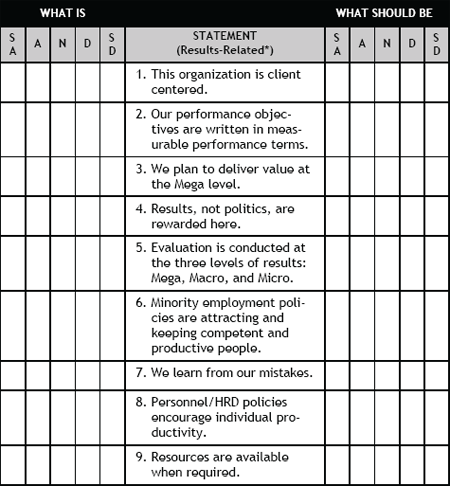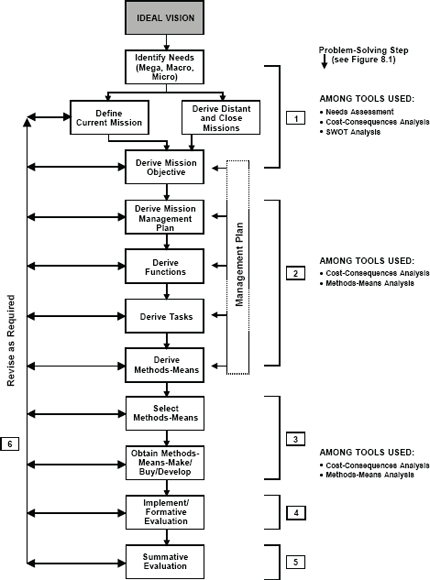Using the What Is and What Should Be Format for Collecting Data
An advantage of using need as a noun—gap in results—is that you can use the What Is and What Should Be format to collect useful data and define gaps in results all at the same time. Use the following scale to indicate your level of agreement with each statement:
SA – Strongly Agree
A – Agree
N – Neutral
D – Disagree
SD – Strongly Disagree


This format—based on a needs assessment approach—is very useful for collecting data and ensuring that the data collection identifies gaps between current results and desired results. Because this type of data collection is “soft” or observational data, it is strongly urged that such be compared to “hard” performance data.
How do needs assessments you have used or know about stack up with the requirements for delivering useful data? The following could be useful when you are considering a needs assessment you have been involved in, or looking at one that has been used before.
Using a needs assessment you have developed or recall being used:
| Compare your needs assessment and determine if it includes: | ||
| 1a. | Mega level data, | |
| 1b. | Macro level data, and/or | |
| 1c. | Micro level data. | |
| (It might be that it is “none of the above”). | ||
| Note: A way to determine if it is Mega (societal) focused is to determine if elements of an Ideal Vision (Figure 3.1) are included. | ||
| 2. | Does your needs assessment focus on ends and not means? | |
| 3. | What are the implications for your internal (organizational) and external clients’ success that will be delivered by the needs assessment you are comparing relative with this (Mega) approach and this exercise? | |
| 4. | Does your needs assessment use a combination of “hard” and “soft” data? Is this data collected from a variety of data sources throughout the organization? | |
Follow-on questions:
5. If the needs assessment does not include a Mega level focus or links, what will it take to modify it?
6. What are the penalties and payoffs for you and your internal and external clients for using a Mega-level-linked needs assessment? For not using a Mega-level-linked needs assessment?
7. Why do you think most needs assessment models and frameworks don’t include or link to the Mega level?
Moving from Mega to Macro to Micro to Processes to Inputs: Solving problems. It is not enough to identify and prioritize needs, nor is it enough to just identify the requirements for success—for change. While not the topic of this book4, Figure 8.3 shows the functions, or steps, required to get from “here” to “there”—to deliver success5.
Mega Thinking and Planning is about defining a shared success, achieving it, and being able to prove it. Mega Thinking and Planning is a focus not on one’s organization alone but on society now and in the future. It is about adding measurable value to all stakeholders.
Figure 8.3. A relationship map of Mega Thinking and Planning, and doing: Relating tools and concepts.6
Use the conceptual map in Figure 8.3 as a guide for Mega Thinking and Planning. This framework relates the functions for strategic thinking and planning—from the Ideal Vision through design, development, implementation, and evaluation/continual improvement. In addition, it shows how each phase of the strategic thinking and planning cycle relates to the six-step problems-solving process (Figure 8.4).
A six-step process for identifying and resolving problems (and identifying opportunities). When progressing, the following six functions will guide you to perform. They start with assessing needs—gaps in results—and placing them in priority order on the basis of the costs to meet the needs as compared to the costs to ignore the needs.
A six-step problem-solving process model, shown in Figure 8.4, in terms of results (and not the processes to deliver each result) includes (1.0) assessing needs, which defines the gaps in results at the Mega, Macro, and Micro levels and places them in priority order; (2.0) analyzing needs (gaps in results) to find the causes of the needs, determine detailed solution requirements to meet the needs, and identify (but not yet select) solution alternatives; (3.0) selecting methods and means, which involve selecting solutions from among alternatives based on the costs and consequences for the available alternatives; (4.0) implementing, which consists of designing and developing the means and methods that are required to meet the needs, and then putting those to work; (5.0) evaluating, where the results are compared with the intentions (from 2.0); and (6.0) revising as required, which involves the continual improvement (at each and every step) when the required results are not being accomplished or when progress toward meeting the needs is falling short.
The Six-Step Problem-Solving Process
Figure 8.4. The six-step problem solving process: A process for identifying and resolving problems (and identifying opportunities).7
This problem-solving process will allow you to manage the entire planning and change process. It suggests the steps that start with
• 1.0, identifying a problem from a needs assessment, to
• 2.0, determining solution requirements and identifying alternative methods and means for meeting the needs, then
• 3.0, selecting the most effective methods and means, to
• 4.0, implementing what was planned and designed, to
• 5.0, evaluation of what worked and what did not.
There is the continuous and dynamic “revise as required” step—6.0—that encourages revising whenever and wherever proper progress is not being made.


